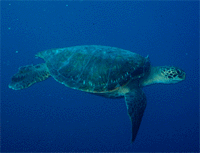Green sea turtle sightings have been incorporated into the Hawaii REEF Survey Project. Read on to learn more about the turtles and why they were included.

Green sea turtle, known as honu in Hawaiian, is the most commonly sighted of the three species of sea turtles found in Hawaiian waters. Hawaii came dangerously close to loosing this magnificent creature, but after receiving endangered species protection in 1978, the species has made an encouraging comeback. Green sea turtles are vegetarians (unique among sea turtle species) and they are so named for the green appearance of their body fat (tinted by the plants they eat). They are extremely slow growing, taking approximately 20 years to reach breading adult size of 200 pounds or more. The other two species of sea turtle in Hawaii are the hawksbill and the leatherback. Although you are unlikely to see either of these while diving, green sea turtles can be distinguished from the other species by the placement of the scutes on the shell and the shape of the head.
Fibropapillomatosis (FP) Tumors

Green sea turtle populations in Hawaii are threatened by the growing incidence of fibrous growths on the eyes, neck, flippers, and in the mouth. The cause of the tumors is still unknown, and the tumor forming disease is also present in other areas, including Florida, Barbados, Australia, and the Pacific coasts of Mexico and Costa Rica. FP tumors interfere with the reptile's ability to feed, eat and swim, and unfortunately FP tumors are often fatal. In some parts of Hawaii, it is estimated that the disease is present in 60% of the turtles. You can find out more about this epidemic at the Turtle Trax Website at www.turtles.org.
Including Turtle Sightings in REEF's Hawaii Program
In an effort to provide useful information to the National Marine Fisheries Service (NMFS) and others studying FP, REEF has included sightings of both healthy and FP-inflicted green sea turtles in our survey protocol for Hawaii. In addition to marking the information on our survey form, you can provide additional information on tumor severity and turtle size directly to NMFS using their turtle sightings form. This form can be downloaded as a pdf file here or you can contact the NMFS lab at 808-983-5733.
NMFS Turtle Sighting Form
Remember that all sea turtles are protected as endangered species under state and federal law. Harassment and disturbance are strictly prohibited. This includes any physical contact with a turtle.
